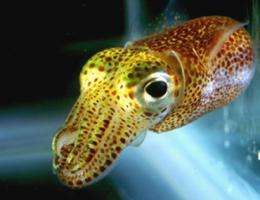In sync: Squid, glowing companions march in genetic harmony

(PhysOrg.com) -- Most humans are blissfully unaware that we owe our healthful existence to trillions of microbes that make their home in the nooks and crannies of the human body, primarily the gut.
During evolutionary history, humans and bacteria have forged a mutually beneficial coexistence that provides the microbes' room and board in exchange for an array of biochemical services that help support everything from the digestion of food to a robust immune system.
But the intimate details of the relationship — how the cells of the host and the cells of the bacteria coexist and interact — are murky. Now, however, with the help of a diminutive Pacific Ocean squid and the bioluminescent bacteria that colonize its light-emitting, predator-fooling organ, scientists may have found a key to how animal hosts and their microbial symbionts maintain a healthy, rhythmic coexistence.
In a study published this week this week (Jan. 18) in the Proceedings of the National Academy of Sciences, researchers led by Margaret McFall-Ngai and Edward Ruby, professors of medical microbiology and immunology at the University of Wisconsin-Madison, chart the genetic interplay of symbiosis, revealing a daily molecular choreography that may well be characteristic of higher animals, including humans. If true, the insight would have important practical implications for human and animal health, as similar events occur when our tissues are colonized by the germs that make us sick.
"Nobody has a good handle on how the balance between host and symbiont is achieved," notes McFall-Ngai.
The Wisconsin researchers have studied the symbiotic interplay between the tiny Hawaiian bobtail squid, a two-inch creature common to the warm waters of the Pacific, and a glowing bacterium, Vibrio fischeri, for more than 20 years. The microbe colonizes and powers the animal's light organ, which serves to confuse squid predators lurking in the ocean depths at night when the squid is most active.
The idea behind the new study, explains McFall-Ngai, was to document the daily genetic dialogue between the bacterial symbionts and host-squid cells. Using microarrays that reveal which genes of the partners in an interaction are turned on or off, the group led by McFall-Ngai and Ruby found a daily pattern of activity that seems to show how host and bacterium maintain a healthy and balanced relationship.
"We found it is an extremely dynamic interaction, a profound daily rhythm on the part of both partners," says McFall-Ngai.
Several years ago, the Wisconsin researchers discovered that each day at dawn the bobtail squid expels about 90 percent of the bacteria that colonize its light organ. It had also been noted that the intensity of the bacterium's bioluminescence waxed and waned, with the most light produced at night when the squid is most active and most vulnerable to predators.
The new PNAS study assessed at different times of day the genetic activity of the squid host cells that support the bacterial symbionts as well as the bacteria themselves.
"Just before dawn, the animal turns on the majority of the genes associated with the cytoskeleton," the internal scaffolding of cells, according to McFall-Ngai. A close look at the tissues using electron microscopy revealed that the structure of the tissue colonized by Vibrio fischeri was dramatically disrupted at that time, with portions of the host-squid membranes shed into the spaces that the bacteria colonize.
Similar cytoskeletal changes have previously been observed in human pathogenesis, for example, in the destruction of intestinal tissues by E. coli 0157, which occurs in contaminated hamburger.
In the case of the squid, just after dawn and following the daily expulsion of the symbionts, the animal shuts down the genes of the cytoskeleton. As the residual symbionts begin to repopulate the tissues, the squid's cells regain their highly organized daytime condition. In response to the released host membranes, the bacteria turn on all the genes and pathways associated with using those membranes as food. Once that nutrient supply is exhausted, the squid then provide the symbionts with complex sugars for sustenance.
The bacteria, says McFall-Ngai, seem to be cycling through different metabolic states in response to different food sources provided by the host. The details teased out of the squid and its bioluminescent bacterium, says McFall-Ngai, may be more generally applicable to animal-microbial associations: "It is quite likely that such daily rhythms on the maintenance of animal-bacterial symbioses are more universal than in just this little squid."
More information: www.pnas.org/
Provided by University of Wisconsin-Madison
















